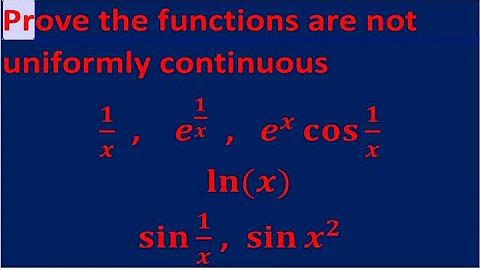Cos 1 x is Not Uniformly Continuous
Is $f(x)= \cos(e^x)$ uniformly continuous?
Solution 1
There is uniform continuity for $x \in (-\infty,0]$, because the derivative $f'(x)=-e^x \sin(e^x)$ is bounded there ($|f'(x)| \le 1$ there):
Let $\varepsilon>0$ be given, and suppose $|x_1-x_2|<\delta=\varepsilon$. Apply Lagrange's mean value theorem: $|f(x_1)-f(x_2)|=|f'(\xi)| |x_1-x_2| \le 1 \cdot |x_1-x_2|<\varepsilon$. ($\xi$ is some number between $x_1$ and $x_2$).
There is no uniform continuity on $[0,+\infty)$ though. To see this look at the pairs of points $x_n=\ln (2\pi n),y_n=\ln((2n+1) \pi)$, they get closer than any $\delta$, yet the distance between their f-value is always 2.
Solution 2
The derivative is not needed, you can replace $\cos$ with any nonconstant periodic continuous function $g$:
Let $g\colon \mathbb R\to\mathbb R$ be
- continuous
- non-constant
- periodic.
Then for any $a\in \mathbb R$, the function $f(x):=g(e^x)$ is
- uniformly continuos on $(-\infty,a]$
- not uniformly continuous on $[a,\infty)$
Proof: Every continuous function is continous on compact intervals, therefore every periodic continous function is uniformly continuous
Let $\epsilon>0$ be given. Then there exists $\delta>0$ such that $|g(x)-g(y)|<\epsilon$ if $|x-y|<\delta$. Wlog. $\delta<e^a$. Then $0<1-\delta e^{-a}<1$ ad hence $\delta':=-\ln(1-\delta e^{-a})>0$. Now consider $x,y<a$ with $|x-y|<\delta'$. Wlog. $x\le y$. Then $$e^y-e^x=e^y(1-e^{x-y})<e^a(1-e^{-\delta'})=\delta$$ and hence $$ |f(x)-f(y)|=|g(e^x)-g(e^y)|<\epsilon.$$ Thus $f$ is uniformly continuous on $(-\infty,a]$.
As $g$ is not constant, there exist $x_1, x_2$ with $g(x_1)\ne g(x_2)$. Let $\epsilon=|g(x_1)-g(x_2)|>0$. Let $p>0$ be a period of $g$. No matter how small we choose $\delta>0$, for sufficiently big $k\in\mathbb Z$ (especially with $x_i+kp>e^a>0$), we have $|\ln(x_1+kp)-\ln(x_2+kp)|<\delta$ because $$\ln(x_1+kp)-\ln(x_2+kp)=\ln\frac{x_1/k+p}{x_2/k+p}\to\ln1=0$$ as $k\to+\infty.$ But then $$|f(\ln(x_1+kp))-f(\ln(x_2+kp))|=|g(x_1+kp)-g(x_2+kp)|=|g(x_1)-g(x_2)|=\epsilon $$ so we se ethat $f$ is not uniformly continuous on $[a,\infty)$. $_\square$
Solution 3
Note that $f$ is differentiable on $\mathbb{R}$ and $f'(x)=-e^x\sin{(e^x)}.$
Let $x_n=\ln{\left(\dfrac{\pi}{6}+2\pi n\right)}, \;\; y_n= \ln{\left(\dfrac{\pi}{3}+2\pi n\right)}.$ Then $$|x_n-y_n| = {\ln{\left(\dfrac{\pi}{3}+2\pi n\right)} -\ln{\left(\dfrac{\pi}{6}+2\pi n\right)}}=\ln{\dfrac{\dfrac{\pi}{3}+2\pi n}{{\dfrac{\pi}{6}+2\pi n}}}=\\ = \ln{\left(1+\dfrac{1}{1+12 n }\right)}\sim \dfrac{1}{1+12 n }, \;\; n\to \infty .$$
By the mean value ( Lagrange's) theorem $$|f(x_n)-f(y_n|=|f'(\xi_n)|\cdot|x_n-y_n|=e^{\xi_n}|\sin(e^{\xi_n})|\cdot|x_n-y_n|\geqslant \\ \geqslant e^{x_n}\cdot\dfrac{1}{2}\cdot\dfrac{1}{1+12 n }=\dfrac{\dfrac{\pi}{6}+2\pi n}{2+24n} \underset{n\to\infty}{\rightarrow} \dfrac {\pi}{12},$$ which proves that $f$ is not uniformly continuous on $[0,\;+\infty)$.
Solution 4
It is uniformly continuous on the interval $(-\infty,0]$. To see that, use the mean value theorem twice.
Added: Exploiting the identies $ |\cos(t) - \cos(z)|\leq | t-z | $ and $ |e^x - e^y| \leq | {x}-{y} | $ on $(-\infty,0]$, which they can be proved by the mean value theorem, we have
$$ | \cos(e^{x}) - \cos(e^{y})|\leq | e^{x}-e^{y} |\leq| x-y |< \epsilon=\delta. $$
Related videos on Youtube
Comments
-
As in the topic, my quest is to check (and prove) whether the given function $$f(x)= \cos(e^x)$$is uniformly continuous on $\left\{\begin{matrix}x \in (-\infty;0] \\ x \in [0; +\infty) \end{matrix}\right.$ .
My problem is that I have absolutely no idea how to do it. Any hints will be appreciated and do not feel offended if I ask you a question which you consider stupid, but such are the beginnings. Thank you in advance.
-
Do you know what "uniformly continuous" means?
-
On $(-\infty,0]$, use the mean value theorem to show is it $1$-Lipschitz.
-
that i can "draw it without hettin goff pencil"
-
No, that's (somehow) continuous.
-
I know Lipschitz but what is 1-Lipschitz?
-
there is no challenge in proving this for the negative $x$ part... the other part is a bit challenging...
-
$1$-Lipschitz means that the Lipschitz constant is $1$. But you're right, it is enough to say that $f$ is Lipschitz.
-
-
Why twice? I think once is enough.
-
@julien: he needs to bound $|e^x-e^y|$ too.
-
@MhenniBenghorbal. He only needs bound for the derivative of $f$.
-
$|f'(x)|=|e^x\sin (e^x)|\leq 1$ so (mvt, once) $f$ is $1$-Lipschitz, so $f$ is uniformly continuous.
-
Do not forget it is a composed function.
-
I don't forget it... I did the chain rule. To find $\|f'\|_\infty\leq 1$ on $(-\infty,0)$ so $|f(x)-f(y)|\leq |x-y|$. Mvt, once...
-
Are you sure the distance of the $f$-values of $x_n$ and $y_n$ is always $2$, and not $1$? Isn't $\cos (2n\pi)=0$ and $\cos(2n\pi+\pi)=-1$ for all $n$?
-
If by Lagrange theorem you mean the mean value theorem, how do you do that?
-
@ThomasE. Really? $\cos (2n\pi)=0$?
-
@julien. Ah, shoot. It's $1$ :) made a silly mistake when drawing the circle. Then their difference is $2$ as wanted.
-
Apparently, you think that the mvt yields $f(x)-f(y)=f'(c)(e^x-e^y)$ for some $c$ in $(x,y)$. Can't you see the problem?
-
Ah, ok. I just thought it was much more trouble than the explicit estimate by Michael Touitou. Thanks for the edit, though.
Recents
Source: https://9to5science.com/is-f-x-cos-e-x-uniformly-continuous





0 Response to "Cos 1 x is Not Uniformly Continuous"
Post a Comment